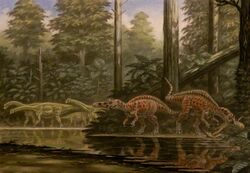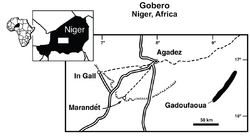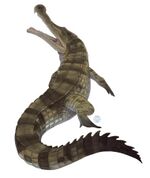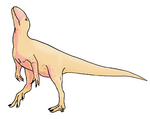(diff) ← Older revision | Latest revision (diff) | Newer revision → (diff)
The Elrhaz Formation is a geological formation in Niger, West Africa.
Its strata date back to the Early Cretaceous, about 125 to 112 million years ago. Dinosaur remains are among the fossils that have been recovered from the formation, alongside those of multiple species of crocodyliformes.
Gadoufaoua

Reconstructed skeleton of an anhanguerid from the formation
Gadoufaoua (Tuareg for "the place where camels fear to go") is a site within the Elrhaz Formation (located at [ ⚑ ] 16°50′N 9°25′E / 16.833°N 9.417°E / 16.833; 9.417) in the Tenere desert of Niger known for its extensive fossil graveyard. It is where remains of Sarcosuchus imperator, popularly known as SuperCroc, were found (by Paul Sereno in 1997, for example), including vertebrae, limb bones, armor plates, jaws, and a nearly complete 6 feet (1.8 m) skull.

Dinosaurs of Elrhaz formation
Gadoufaoua is very hot and dry. However, it is supposed that millions of years ago, Gadoufaoua had trees, plants, and wide rivers. The river covered the remains of dead animals, the fossilized remains of which were protected by the drying rivers over millions of years.[1]
Vertebrate paleofauna
Chondrichthyes
| Chondrichthyes
|
| Genus |
Species |
Material |
Notes |
Images
|
| Hybodus[2]
|
H. sp.
|
Dorsal spines[2]
|
|
|
Sarcopterygii
| Sarcopterygii
|
| Genus |
Species |
Material |
Notes |
Images
|
| Asiatoceratodus[2]
|
A. tiguidiensis[2]
|
|
Dipnomorph fish. Originally described as Ceratodus tiguidiensis,[3] assigned to Arganodus by M. Martin (1984)[4] and reassigned by Kemp (1998) to the genus Asiatoceratodus.[5]
|
|
| Mawsonia[6]
|
M. tegamensis[7]
|
|
A small species.[8]
|
|
| Neoceratodus[2]
|
N. africanus[2]
|
Tooth plates.[9]
|
Dipnomorph fish. Originally described as Ceratodus africanus, assigned to Neoceratodus by M. Martin, 1982.[10]
|
 Neoceratodus forsteri, a modern species |
Actinopterygii
Testudines
| Testudines
|
| Genus |
Species |
Material |
Notes |
Images
|
| Francemys[13]
|
F. gadoufaouaensis[13]
|
"Shell of a juvenile individual and several articulated and disarticulated plates."[13]
|
Pelomedusoid turtle. Named in honour of France de Lapparent de Broin.[13]
|
|
| Taquetochelys[14]
|
T. decorata[14]
|
A few disarticulated plates and nearly complete skeleton.[15]
|
Araripemydid turtle, similar in shell size to South American Araripemys (20–30 cm). Laganemys tenerensis was synonimysed with Taquetochelys by Pérez-García, 2018.[15]
|
|
| Teneremys[14]
|
T. lapparenti[14]
|
"Several relatively complete skeletons."[13]
|
|
|
Crocodyliformes
Ornithischians
Theropods
| Theropods
|
| Genus |
Species |
Material |
Notes |
Images
|
| Afromimus
|
A. tenerensis
|
"caudal vertebrae, chevrons and portions of the right hind limb"[21]
|
A Noasaurid
|
|
| Eocarcharia[16]
|
E. dinops[22]
|
"Partial skull and postcranial remains."[23]
|
Carcharodontosaurid
|
|
| Kryptops[16]
|
K. palaios[16]
|
Postcranial skeleton and partial skull.[24]
|
Abelisaurid
|
|
| Suchomimus[16]
|
S. tenerensis[16]
|
Partial skull and associated skeleton.[25]
|
A second, spinosaurid found in the formation, Cristatusaurus, is considered either a separate species or a synonym to Suchomimus[26]
|
|
Sauropods
See also
References
- ↑ SCIENCE IN THE NEWS - Nov. 13: Digest - 12 November 2001 Voice of America
- ↑ 2.0 2.1 2.2 2.3 2.4 2.5 2.6 "On the dinosaurian and crocodilian locality of Gadoufaoua (Republic of
Niger)" (PDF). From Mr. Philippe Taquet (1970), presented by Mr. Jean Piveteau.
- ↑ N. Tabaste. 1963. Étude derestes de poissons du Crétacé saharien [Study of fish remains from the Saharan Cretaceous]. Mélanges Ichthyologiques Dédiés à la Mémoire d’Achille Valenciennes (1794–1865). Mémoires de l’Institute Français d’Afrique Noire 68:437-485
- ↑ Martin, M., 1984. Révision des Arganodontidés et des Néocératodontidés (Dipnoi,
Ceratodontiformes) du Crétacé africain. Neues Jb. Geol. Paläontol. Abh. 169, 225–260.
- ↑ Kemp, A. 1998. Skull structure in post-paleozoic lungfish. Journal of Vertebrate Paleontology, 18(1): 43-63.
- ↑ "Fossilworks: Gateway to the Paleobiology Database". http://www.fossilworks.org/cgi-bin/bridge.pl?a=collectionSearch&collection_no=37200.
- ↑ "Fossilworks: Gateway to the Paleobiology Database". http://www.fossilworks.org/cgi-bin/bridge.pl?a=collectionSearch&collection_no=37200.
- ↑ Taquet, Philippe (1998). Dinosaur impressions : postcards from a paleontologist. Internet Archive. Cambridge ; New York : Cambridge University Press. ISBN 978-0-521-58372-5. http://archive.org/details/dinosaurimpressi00taqu.
- ↑ Federico Fanti, Gabriele Larocca Conte, Luana Angelicola, Andrea Cau, 2016. "Why so many dipnoans? A multidisciplinary approach on the Lower Cretaceous lungfish record from Tunisia." Palaeogeography, Palaeoclimatology, Palaeoecology. 449: 255-265. DOI:10.1016/j.palaeo.2016.02.024
- ↑ M. Martin. 1982. Nouvelles données sur la phylogénie et la systématique des dipneustes postpaléozoïques [New data on the phylogeny and systematics of post-Paleozoic dipnoans]. Comptes Rendues de l'Academie des Sciences, Paris, Série II 294:611-614
- ↑ 11.0 11.1 S. Wenz. 1999. Pliodetes nigeriensis, gen. nov. et. sp. nov., a new semionotid fish from the Lower Cretaceous of Gadoufaoua (Niger Republic): phylogenetic comments. In G. Arratia & H.-P. Schultz (ed.), Mesozoic Fishes 2—Systematics and Fossil Record 107-120
- ↑ 12.0 12.1 A. López-Arbarello. 2012. Phylogenetic interrelationships of ginglymodian fishes (Actinopterygii: Neopterygii). PLoS ONE
- ↑ 13.0 13.1 13.2 13.3 13.4 Pérez-García, Adán (1 October 2019). "The African Aptian Francemys gadoufaouaensis gen. et sp. nov.: New data on the early diversification of Pelomedusoides (Testudines, Pleurodira) in northern Gondwana" (in en). Cretaceous Research 102: 112–126. doi:10.1016/j.cretres.2019.06.003. ISSN 0195-6671.
- ↑ 14.0 14.1 14.2 14.3 F. de Broin. 1980. Les tortues de Gadoufaoua (Aptien du Niger); aperçu sur la Paléobiogéographie des Pelomedusidae (Pleurodira). Mémoires de la Société Géologique de France
- ↑ 15.0 15.1 Pérez-García, Adán (2018). "Identification of the Lower Cretaceous pleurodiran turtle Taquetochelys decorata as the only African araripemydid species" (in en). Comptes Rendus Palevol 18: 24–32. doi:10.1016/j.crpv.2018.04.004. ISSN 1631-0683.
- ↑ 16.00 16.01 16.02 16.03 16.04 16.05 16.06 16.07 16.08 16.09 16.10 16.11 16.12 16.13 16.14 "68.1 Departement D'Agedez, Niger; 1. Elrhaz Formation," in Weishampel, et al. (2004). Page 572
- ↑ Sereno et al., 2011
- ↑ "Table 19.1," in Weishampel, et al. (2004). Page 415.
- ↑ "Table 19.1," in Weishampel, et al. (2004). Page 416.
- ↑ "Table 19.1," in Weishampel, et al. (2004). Page 417.
- ↑ Sereno, P. (2017). "Early Cretaceous ornithomimosaurs (Dinosauria: Coelurosauria) from Africa". Ameghiniana. 54 (5): 576–616. doi:10.5710/AMGH.23.10.2017.3155.
- ↑ Sereno & Brusatte, 2008
- ↑ "Table 4.1," in Weishampel, et al. (2004). Page 73.
- ↑ "Table 4.1," in Weishampel, et al. (2008). Page 72.
- ↑ "Table 4.1," in Weishampel, et al. (2004). Page 72.
- ↑ Rauhut, O.W.M. (2003). "The interrelationships and evolution of basal theropod dinosaurs". Special Papers in Palaeontology 69: 1-213.
Bibliography
Further reading
- P. M. Galton and P. Taquet. 1982. Valdosaurus, a hypsilophodontid dinosaur from the Lower Cretaceous of Europe and Africa. Géobios 15(2):147-159
- H. C. E. Larsson and B. Gado. 2000. A new Early Cretaceous crocodyliform from Niger. Neues Jahrbuch für Geologie und Paläontologie - Abhandlungen 217(1):131-141
- P. C. Sereno and S. J. ElShafie. 2013. A New Long-Necked Turtle, Laganemys tenerensis (Pleurodira: Araripemydidae), from the Elrhaz Formation (Aptian–Albian) of Niger. In D. B. Brinkman, P. A. Holroyd, J. D. Gardner (eds.), Morphology and Evolution of Turtles 215-250
- P. C. Sereno and H. C. E. Larsson. 2009. Cretaceous crocodyliformes from the Sahara. ZooKeys 28:1-143
- P. C. Sereno, A. L. Beck, D. B. Dutheil, B. Gado, H. C. E. Larsson, G. H. Lyon, J. D. Marcot, O. W. M. Rauhut, R. W. Sadleir, C. A. Sidor, D. D. Varricchio, G. P. Wilson, and J. A. Wilson. 1998. A long-snouted predatory dinosaur from Africa and the evolution of spinosaurids. Science 282:1298-1302
 | Original source: https://en.wikipedia.org/wiki/Elrhaz Formation. Read more |



















